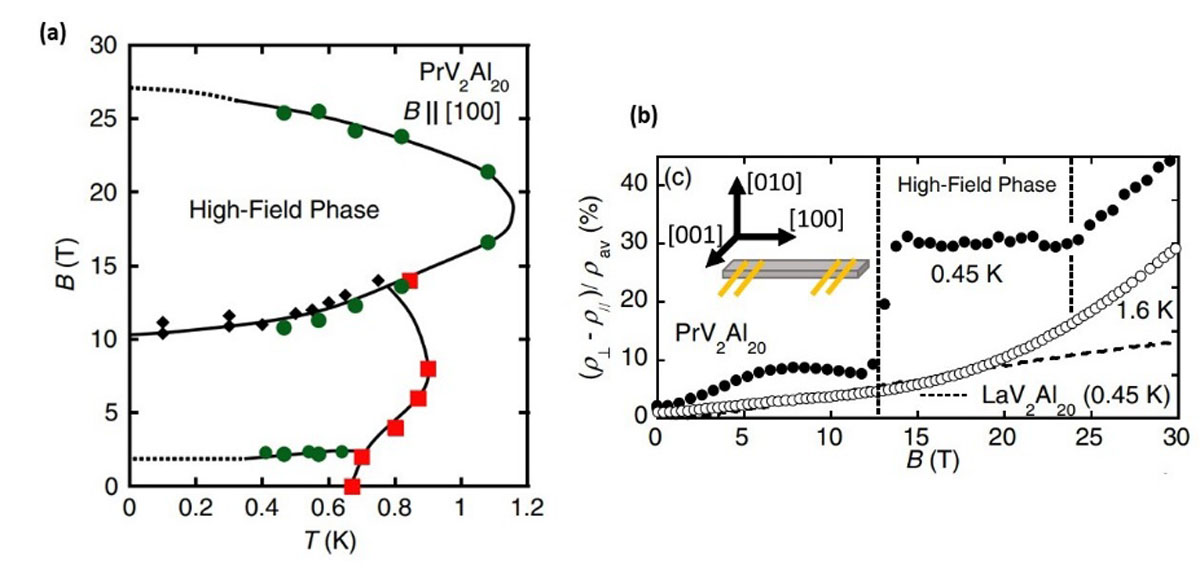Orbital-Driven Giant Anisotropic Magnetoresistance in the Quadrupolar Heavy Fermion Superconductor PrV2Al20
Nakatsuji and Sakakibara Groups
The quest for a mechanism that realizes significant transport anomalies in non-ferromagnetic materials may spark a breakthrough in developing ultrafast and energy-efficient memory devices [1,2]. An example of such transport anomaly is anisotropic magnetoresistance (AMR), defined as the difference between the resistance with current applied parallel and perpendicular to the ordered spin direction. To date, however, the AMR effect found in antiferromagnetic materials is limited to a small value of 1% - 2% [3,4]. Rearrangement of electron orbitals may hold the key to further enhancing the AMR in non-ferromagnetic systems, as it should generate anisotropy in the electronic band structure, thereby inducing dramatic effects on the transport properties. A promising discovery along this line is the strongly anisotropic magnetoresistance appearing within the nematic order phase in iron-based superconductors.
Here, we focus on a cubic heavy fermion compound PrV2Al20. A unique feature of this material is its nonmagnetic Γ3 ground-state doublet, in which the magnetic dipole moment is absent, whereas the quadrupole and octupole moments are active [5], offering an ideal stage for investigating transport phenomena driven solely by electron orbitals. The strong hybridization of these multipolar moments with conduction electrons leads to a rich phase diagram involving a two-stage multipolar order below 0.6–0.7K, non-Fermi-liquid behavior driven by multipolar Kondo effect, and heavy-fermion superconductivity below about 0.05K at ambient pressure [6]. Under a [100] magnetic field, earlier magnetization measurements revealed a high-field phase lying between ~11 – 24T below about 1K [7] (Fig. 1a). This high-field phase is likely the result of rearrangement of the quadrupole moments and therefore is a promising place to explore anisotropic transport properties.
We carried out magnetoresistance measurements under high magnetic fields up to 31.4T at the National High Magnetic Field Laboratory, Tallahassee, USA [8]. Under a [100] magnetic field, we found that, on entering the high-field phase at about 12 T, the rearrangement of quadrupolar moments yields a sharp jump in the magnetoresistance (ΔMR~100%), with a substantial AMR effect of about 30% (Fig. 1b). This feature signifies a Fermi surface reconstruction within the high-field quadrupolar ordered phase, owing to the strong hybridization between the local quadrupolar moment and the conduction electrons. This giant anisotropic magnetoresistance induced by quadrupole rearrangement may form the basis of conceptually new memories and information storage using multipolar states.
References
- [1] S. Nakatsuji, N. Kiyohara, and T. Higo, Nature 527, 212 (2015).
- [2] T. Jungwirth et al., Nat. Nanotechnol. 11, 231 (2016).
- [3] D. Kriegner et al., Nat. Commun. 7, 11623 (2016).
- [4] X. Marti et al., Nat. Mater. 13, 367 (2014).
- [5] A. Sakai and S. Nakatsuji, J. Phys. Soc. Jpn. 80, 063701 (2011).
- [6] M. Tsujimoto et al., Phys. Rev. Lett. 113, 267001 (2014).
- [7] Y. Shimura et al., J. Phys. Soc. Jpn. 82, 043705 (2013).
- [8] Y. Shimura et al., Phys. Rev. Lett. 122, 256601 (2019).

